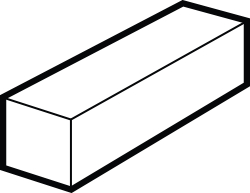
Squares are an extruded product that are very versatile and have a wide range of applications. Squares are widely used for all types of fabrication projects where lightweight and corrosion resistance is a concern.
| Grade | Description |
|---|---|
| 1018 | Mild (low carbon) steel, strong and ductile, has good weldability properties. |
| 1045 | Medium carbon steel that can be forged satisfactorily. Most common shafting steel. |
| 1117 | This is a resulphurized steel with good machinability and surface finish, but not as good as the standard screw stocks. Its case hardening characteristics are superior and it develops an excellent core. It brazes satisfactorily but has no more than fair welding properties. A more ductile steel than others of lower manganese content and it cold forms well. Its machinability is rated at 89% of 1212. |
| 1215 | Free machining steel, commonly referred to as screw machine stock, especially suited for automatic screw machine operations where the major requirement is exceptional free-machining quality with a smooth, bright finish. Poor weldability. |
| 12L14 | A standard resulfurized and rephosphorized grade carbon steel and a free machining steel. The added lead to the chemical composition provides improved machinability but the added lead content also reduces the overall strength of this alloy. |
| A36 | Low carbon steel that exhibits good strength coupled with formability. It is easy to machine and fabricate and can be securely welded. |
| Grade | Description |
|---|---|
| A-2 | Air-hardening steel. Replaces O-1 when safer hardening, better dimensional stability and increased wear-resistance are required. Most widely used in the A series. |
| D-2 | High carbon and high chrome. Ideal grade for maximum production runs. Superior machinability. Excellent wear-resistance, high compressive strength, and deep hardening properties. Most widely used in the D series. |
| M-2 | General purpose high speed steel. Most widely used in the M series. |
| O-1 | Oil Hardening. Easy to machine. Good abrasion resistance. Most widely used in O series. |
| S-7 | Shock resistant tool steel. Used in applications that require high toughness and resistance. Used for moderately elevated temperature service. |
| Grade | Description |
|---|---|
| 4130 | General purpose alloy. Offers good strength and toughness for moderately stressed parts. |
| 4140 | Medium carbon steel that is widely used for general purposes. Good hardenability, strength, toughness, wear resistance, and ductility. |
| 4340 | Highly alloyed steel. Used in heavy-duty conditions and for heavily stressed parts. |
| 8620 | General purpose alloy. It is the most widely used of all case hardening alloys. |
| Grade | Description |
|---|---|
| 360 | Wide range of applications. Highest rated among copper alloys. Fair soldering and brazing capabilities. |
| Grade | Description |
|---|---|
| 110 | Broad range of uses. Excellent hot and cold forming characteristics. Poor machinability rating. |
| Grade | Description |
|---|---|
| 954 | Most popular among bronze alloys. Provides high tensile and yield strength. Good ductility, weldability, and machinability. Excellent resistance to wear, fatigue, and deformation. |
| Grade | Description |
|---|---|
| 2017 | Has high strength with excellent fatigue strength. Alloy 2017 also has very good machining characteristics. It is suitable for welding only by resistance welding. Alloy 2017 is used for various applications from high strength structural components, aircraft, machine construction, military equipment, and rivets. |
| 2024 | One of the most commonly used high strength aluminum alloys. Low corrosion resistance. Commonly used when good strength-to-weight ratio is desired. |
| 6042, 6061, 6063, 6082, 6262 | Heat treatable, structural alloy with medium strength and good weldability, formability, machinability, and relatively good corrosion resistance. |
| 7075 | Highest strength in heat treatable alloys. Adequate machinability and improved stress corrosion control. Good for highly stressed structural parts. |
| Grade | Description |
|---|---|
| 303 | Corrosion resistant to sterilizing solutions, most organic and inorganic chemicals, most dyes, nitric acid, and atmospheric exposures. |
| 304 | Offers resistance to corrosion, has good formability and can be readily welded by all methods. One of the most commonly used grades across the industry. |
| 416 | Good corrosion resistance. Additional sulfur in its chemistry makes 416 easier to machine. |
| 440 F-Se | One of the hardest stainless steels. The extra carbon allows for a long lasting sharp edge when heat treated properly. |